December 13, 2013 at 7:12 pm
[caption id="attachment_63" align="alignright" width="150"]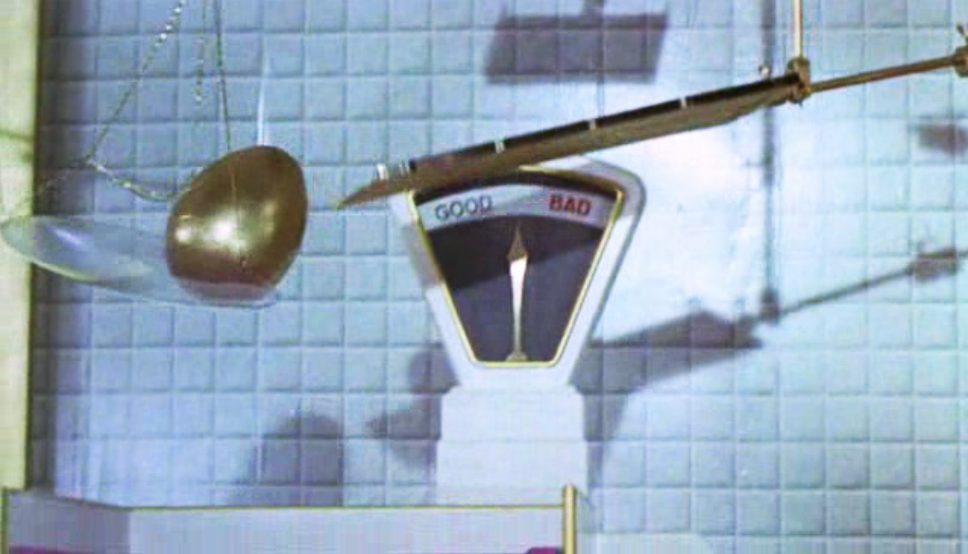 Wonka's Egg-Dicator[/caption]
Willie Wonka, you may remember, possessed an Egg-dicator at his chocolate factory. The machine could magically tell the difference between a good egg, and a bad egg.
Most of Wonka’s golden eggs were good, and shipped throughout the world for Easter. Bad eggs were immediately trashed through a chute. Veruca Salt, one of Wonka’s golden-ticketed guests, inadvertently stood on the Egg-dicator, was deemed rotten and shipped out the garbage chute, following the same fate as other rotten eggs.
Seem farfetched? Well, consider the fact that fiction becomes reality each fall in the Department of Inland Fisheries and Wildlife hatcheries as IFW hatchery staff use an “egg-dicator” to sort through the salmon, trout and togue eggs, separating the good eggs from the bad eggs.
[caption id="attachment_56" align="alignright" width="300"]
Wonka's Egg-Dicator[/caption]
Willie Wonka, you may remember, possessed an Egg-dicator at his chocolate factory. The machine could magically tell the difference between a good egg, and a bad egg.
Most of Wonka’s golden eggs were good, and shipped throughout the world for Easter. Bad eggs were immediately trashed through a chute. Veruca Salt, one of Wonka’s golden-ticketed guests, inadvertently stood on the Egg-dicator, was deemed rotten and shipped out the garbage chute, following the same fate as other rotten eggs.
Seem farfetched? Well, consider the fact that fiction becomes reality each fall in the Department of Inland Fisheries and Wildlife hatcheries as IFW hatchery staff use an “egg-dicator” to sort through the salmon, trout and togue eggs, separating the good eggs from the bad eggs.
[caption id="attachment_56" align="alignright" width="300"]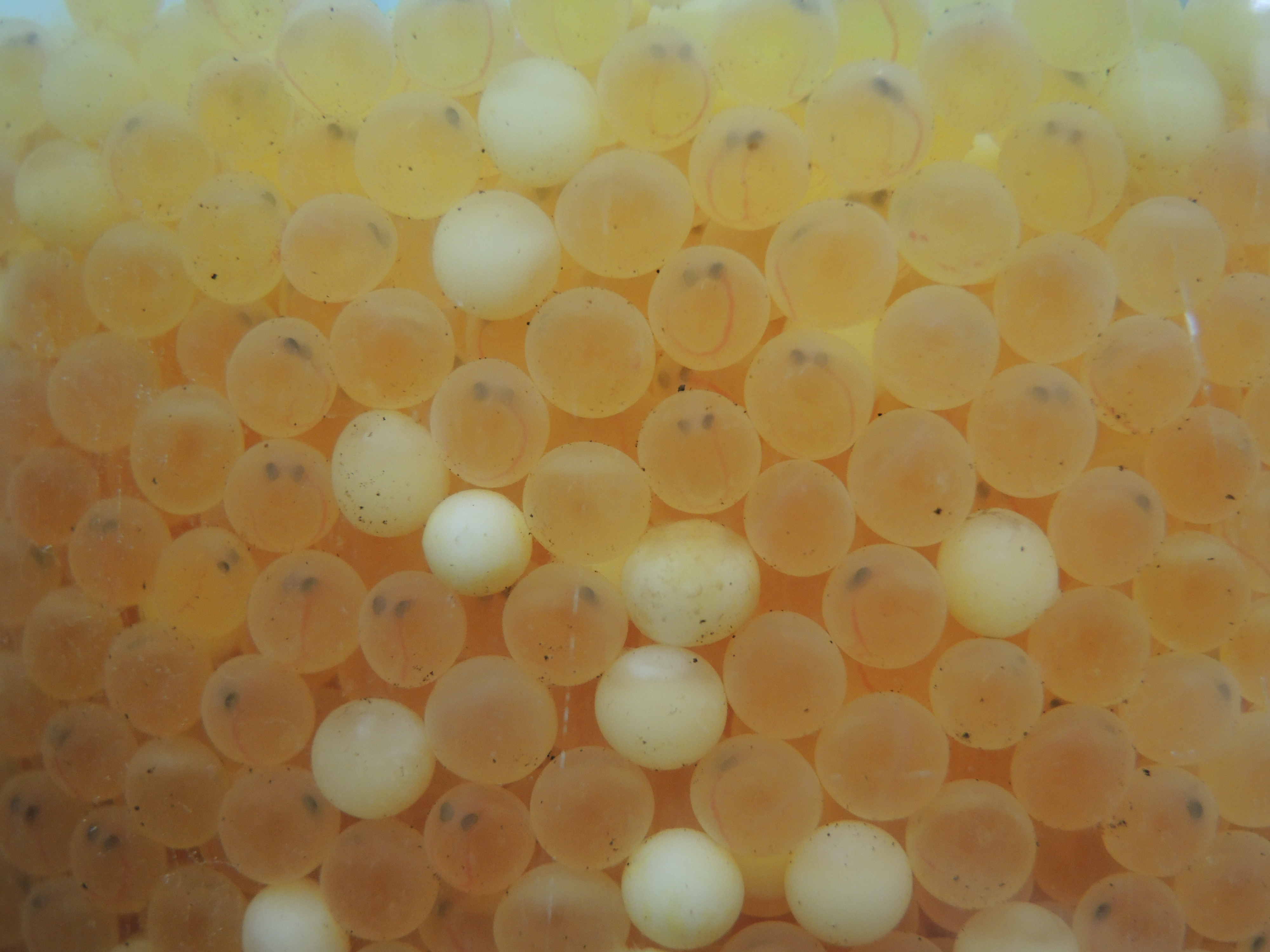 This container holds fertilized brook trout eggs that have eyed up. The white eggs are dead, and will be removed.[/caption]
You see, not every trout or salmon egg is productive. Some are old, some are deformed, some may not get fertilized, but the bottom line is that the rotten eggs need to be discarded. If they aren’t, they become a host for disease, and can kill other viable eggs in the hatchery.
An earlier post showed how IFW hatchery fish culturists fertilize fish eggs. Once fertilized, the eggs are brought to the hatchery, where, guess what?, they hatch. It’s not immediate, it takes several weeks. During that time, bad eggs are discarded to ensure the viability of the good eggs.
It used to be done by hand, but nowadays, the IFW rents a machine that separates the good from the bad. Eggs are placed in a bin, funneled to a spinning wheel that sucks up the eggs where they are eyed by a light. If the light is blocked, a blast of water kicks the egg out and down the garbage chute, while the good eggs continue through until they are deposited in a basket and then moved to hatchery trays and pools.
[caption id="attachment_54" align="alignleft" width="300"]
This container holds fertilized brook trout eggs that have eyed up. The white eggs are dead, and will be removed.[/caption]
You see, not every trout or salmon egg is productive. Some are old, some are deformed, some may not get fertilized, but the bottom line is that the rotten eggs need to be discarded. If they aren’t, they become a host for disease, and can kill other viable eggs in the hatchery.
An earlier post showed how IFW hatchery fish culturists fertilize fish eggs. Once fertilized, the eggs are brought to the hatchery, where, guess what?, they hatch. It’s not immediate, it takes several weeks. During that time, bad eggs are discarded to ensure the viability of the good eggs.
It used to be done by hand, but nowadays, the IFW rents a machine that separates the good from the bad. Eggs are placed in a bin, funneled to a spinning wheel that sucks up the eggs where they are eyed by a light. If the light is blocked, a blast of water kicks the egg out and down the garbage chute, while the good eggs continue through until they are deposited in a basket and then moved to hatchery trays and pools.
[caption id="attachment_54" align="alignleft" width="300"]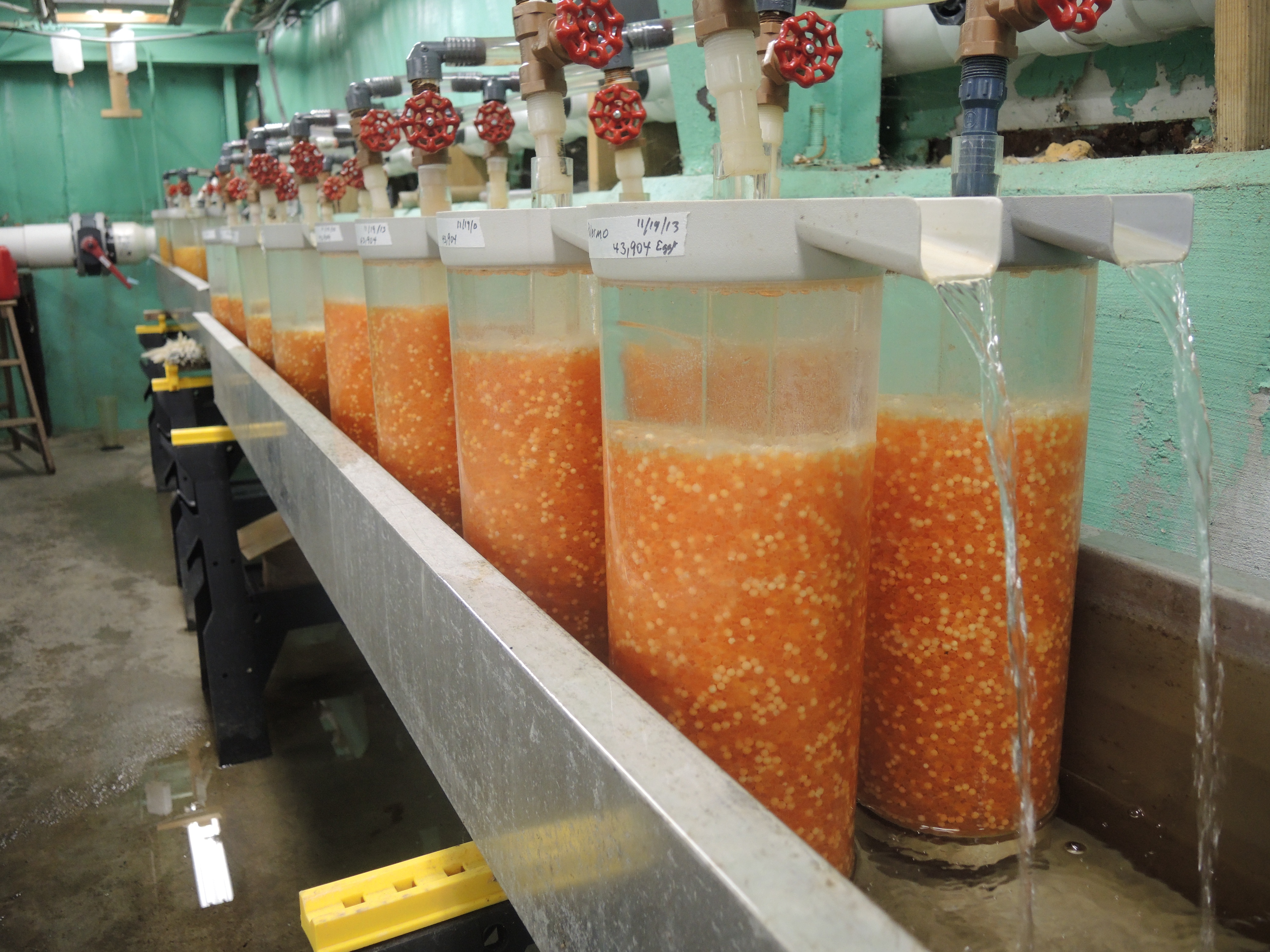 Millions of trout, salmon and togue eggs are stored in these containers until they are near hatching.[/caption]
Hatchery staff processed over 200,000 brook trout eggs today, with about 25% of the eggs discarded. While it may seem like a lot, it’s a better percentage than the wild, where only about 2 percent of the eggs will hatch.
The 200,000 eggs are just a portion of the over 1.5 million eggs that are brought to the Governor Hill Hatchery each year. Over the winter, while some eggs will be discarded, most will hatch. These fish will stay at Governor Hill for a while, then some will be brought to the Grand Lake Stream Hatchery and the Emden Rearing station. There these fish will remain until they are stocked throughout the state.
[caption id="attachment_62" align="alignright" width="300"]
Millions of trout, salmon and togue eggs are stored in these containers until they are near hatching.[/caption]
Hatchery staff processed over 200,000 brook trout eggs today, with about 25% of the eggs discarded. While it may seem like a lot, it’s a better percentage than the wild, where only about 2 percent of the eggs will hatch.
The 200,000 eggs are just a portion of the over 1.5 million eggs that are brought to the Governor Hill Hatchery each year. Over the winter, while some eggs will be discarded, most will hatch. These fish will stay at Governor Hill for a while, then some will be brought to the Grand Lake Stream Hatchery and the Emden Rearing station. There these fish will remain until they are stocked throughout the state.
[caption id="attachment_62" align="alignright" width="300"]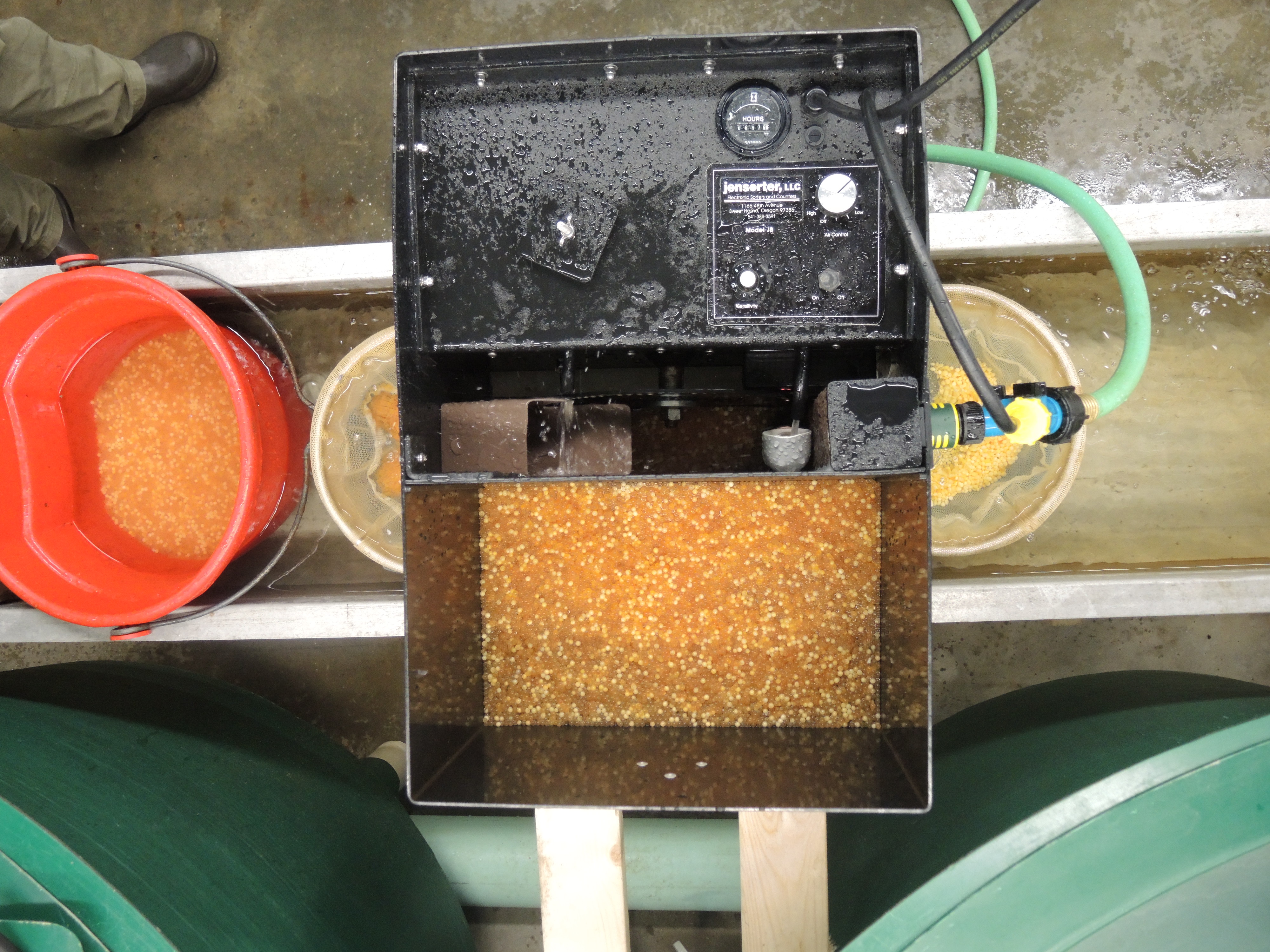 The hatchery version of the Egg-dicator. All eggs are deposited into the bin, sorted by an electric eye, then deposited into a "good" container and a "trash" container.[/caption]
While Wonka’s golden eggs were shipped all over the world, Maine’s hatchery-raised brook trout stay within Maine. Both, however, always seem to bring smiles those who hold them.
Looking for a list of stocked waters in Maine? Please visit the department’s website at http://www.maine.gov/ifw/fishing/reports/stocking/stocking.htm.
[caption id="attachment_59" align="alignleft" width="300"]
The hatchery version of the Egg-dicator. All eggs are deposited into the bin, sorted by an electric eye, then deposited into a "good" container and a "trash" container.[/caption]
While Wonka’s golden eggs were shipped all over the world, Maine’s hatchery-raised brook trout stay within Maine. Both, however, always seem to bring smiles those who hold them.
Looking for a list of stocked waters in Maine? Please visit the department’s website at http://www.maine.gov/ifw/fishing/reports/stocking/stocking.htm.
[caption id="attachment_59" align="alignleft" width="300"]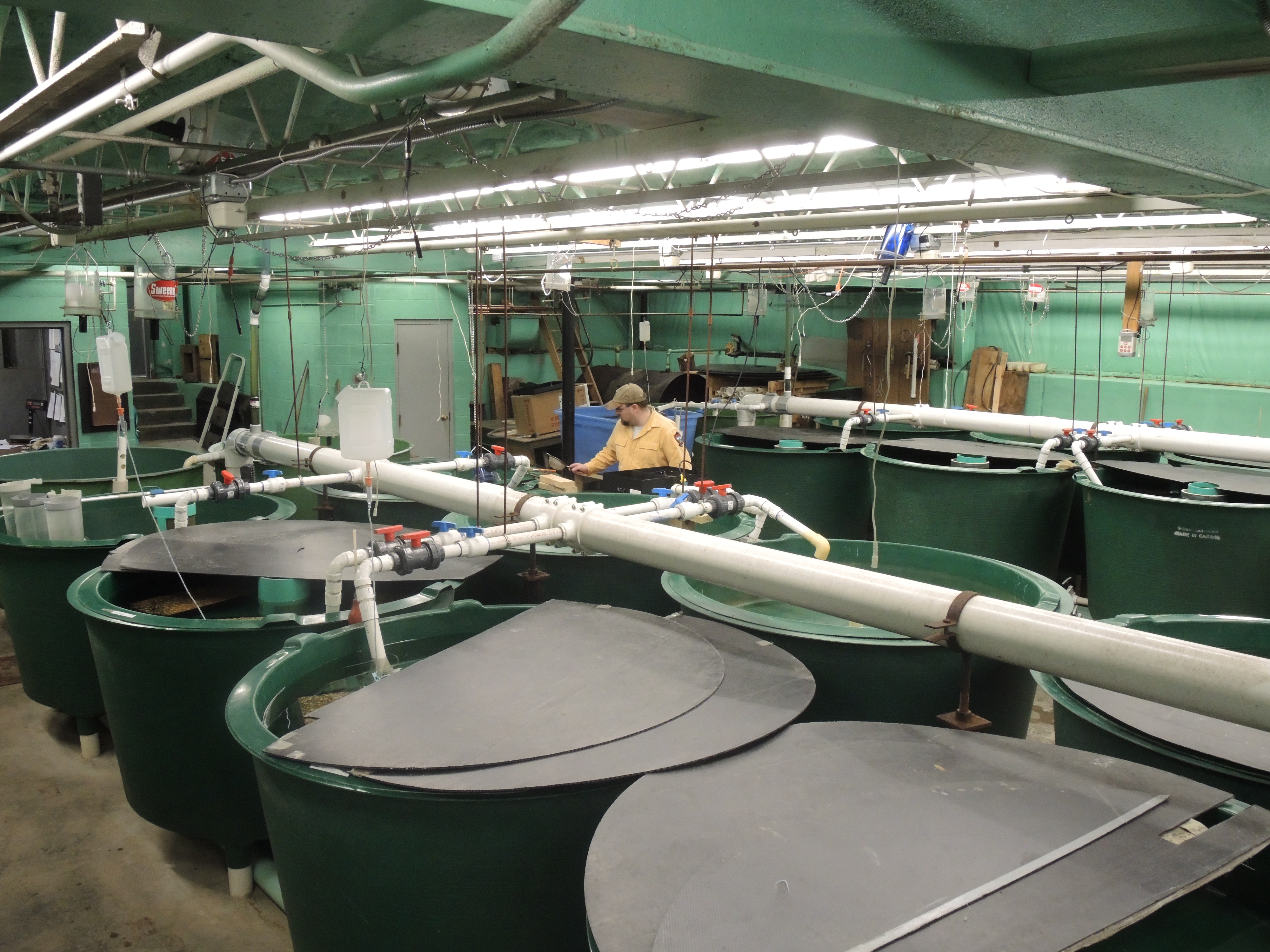 Once sorted, eggs will be placed in trays and set in these large green tanks where they will hatch.[/caption]
Once sorted, eggs will be placed in trays and set in these large green tanks where they will hatch.[/caption]
 Wonka's Egg-Dicator[/caption]
Willie Wonka, you may remember, possessed an Egg-dicator at his chocolate factory. The machine could magically tell the difference between a good egg, and a bad egg.
Most of Wonka’s golden eggs were good, and shipped throughout the world for Easter. Bad eggs were immediately trashed through a chute. Veruca Salt, one of Wonka’s golden-ticketed guests, inadvertently stood on the Egg-dicator, was deemed rotten and shipped out the garbage chute, following the same fate as other rotten eggs.
Seem farfetched? Well, consider the fact that fiction becomes reality each fall in the Department of Inland Fisheries and Wildlife hatcheries as IFW hatchery staff use an “egg-dicator” to sort through the salmon, trout and togue eggs, separating the good eggs from the bad eggs.
[caption id="attachment_56" align="alignright" width="300"]
Wonka's Egg-Dicator[/caption]
Willie Wonka, you may remember, possessed an Egg-dicator at his chocolate factory. The machine could magically tell the difference between a good egg, and a bad egg.
Most of Wonka’s golden eggs were good, and shipped throughout the world for Easter. Bad eggs were immediately trashed through a chute. Veruca Salt, one of Wonka’s golden-ticketed guests, inadvertently stood on the Egg-dicator, was deemed rotten and shipped out the garbage chute, following the same fate as other rotten eggs.
Seem farfetched? Well, consider the fact that fiction becomes reality each fall in the Department of Inland Fisheries and Wildlife hatcheries as IFW hatchery staff use an “egg-dicator” to sort through the salmon, trout and togue eggs, separating the good eggs from the bad eggs.
[caption id="attachment_56" align="alignright" width="300"] This container holds fertilized brook trout eggs that have eyed up. The white eggs are dead, and will be removed.[/caption]
You see, not every trout or salmon egg is productive. Some are old, some are deformed, some may not get fertilized, but the bottom line is that the rotten eggs need to be discarded. If they aren’t, they become a host for disease, and can kill other viable eggs in the hatchery.
An earlier post showed how IFW hatchery fish culturists fertilize fish eggs. Once fertilized, the eggs are brought to the hatchery, where, guess what?, they hatch. It’s not immediate, it takes several weeks. During that time, bad eggs are discarded to ensure the viability of the good eggs.
It used to be done by hand, but nowadays, the IFW rents a machine that separates the good from the bad. Eggs are placed in a bin, funneled to a spinning wheel that sucks up the eggs where they are eyed by a light. If the light is blocked, a blast of water kicks the egg out and down the garbage chute, while the good eggs continue through until they are deposited in a basket and then moved to hatchery trays and pools.
[caption id="attachment_54" align="alignleft" width="300"]
This container holds fertilized brook trout eggs that have eyed up. The white eggs are dead, and will be removed.[/caption]
You see, not every trout or salmon egg is productive. Some are old, some are deformed, some may not get fertilized, but the bottom line is that the rotten eggs need to be discarded. If they aren’t, they become a host for disease, and can kill other viable eggs in the hatchery.
An earlier post showed how IFW hatchery fish culturists fertilize fish eggs. Once fertilized, the eggs are brought to the hatchery, where, guess what?, they hatch. It’s not immediate, it takes several weeks. During that time, bad eggs are discarded to ensure the viability of the good eggs.
It used to be done by hand, but nowadays, the IFW rents a machine that separates the good from the bad. Eggs are placed in a bin, funneled to a spinning wheel that sucks up the eggs where they are eyed by a light. If the light is blocked, a blast of water kicks the egg out and down the garbage chute, while the good eggs continue through until they are deposited in a basket and then moved to hatchery trays and pools.
[caption id="attachment_54" align="alignleft" width="300"] Millions of trout, salmon and togue eggs are stored in these containers until they are near hatching.[/caption]
Hatchery staff processed over 200,000 brook trout eggs today, with about 25% of the eggs discarded. While it may seem like a lot, it’s a better percentage than the wild, where only about 2 percent of the eggs will hatch.
The 200,000 eggs are just a portion of the over 1.5 million eggs that are brought to the Governor Hill Hatchery each year. Over the winter, while some eggs will be discarded, most will hatch. These fish will stay at Governor Hill for a while, then some will be brought to the Grand Lake Stream Hatchery and the Emden Rearing station. There these fish will remain until they are stocked throughout the state.
[caption id="attachment_62" align="alignright" width="300"]
Millions of trout, salmon and togue eggs are stored in these containers until they are near hatching.[/caption]
Hatchery staff processed over 200,000 brook trout eggs today, with about 25% of the eggs discarded. While it may seem like a lot, it’s a better percentage than the wild, where only about 2 percent of the eggs will hatch.
The 200,000 eggs are just a portion of the over 1.5 million eggs that are brought to the Governor Hill Hatchery each year. Over the winter, while some eggs will be discarded, most will hatch. These fish will stay at Governor Hill for a while, then some will be brought to the Grand Lake Stream Hatchery and the Emden Rearing station. There these fish will remain until they are stocked throughout the state.
[caption id="attachment_62" align="alignright" width="300"] The hatchery version of the Egg-dicator. All eggs are deposited into the bin, sorted by an electric eye, then deposited into a "good" container and a "trash" container.[/caption]
While Wonka’s golden eggs were shipped all over the world, Maine’s hatchery-raised brook trout stay within Maine. Both, however, always seem to bring smiles those who hold them.
Looking for a list of stocked waters in Maine? Please visit the department’s website at http://www.maine.gov/ifw/fishing/reports/stocking/stocking.htm.
[caption id="attachment_59" align="alignleft" width="300"]
The hatchery version of the Egg-dicator. All eggs are deposited into the bin, sorted by an electric eye, then deposited into a "good" container and a "trash" container.[/caption]
While Wonka’s golden eggs were shipped all over the world, Maine’s hatchery-raised brook trout stay within Maine. Both, however, always seem to bring smiles those who hold them.
Looking for a list of stocked waters in Maine? Please visit the department’s website at http://www.maine.gov/ifw/fishing/reports/stocking/stocking.htm.
[caption id="attachment_59" align="alignleft" width="300"] Once sorted, eggs will be placed in trays and set in these large green tanks where they will hatch.[/caption]
Once sorted, eggs will be placed in trays and set in these large green tanks where they will hatch.[/caption]Categories